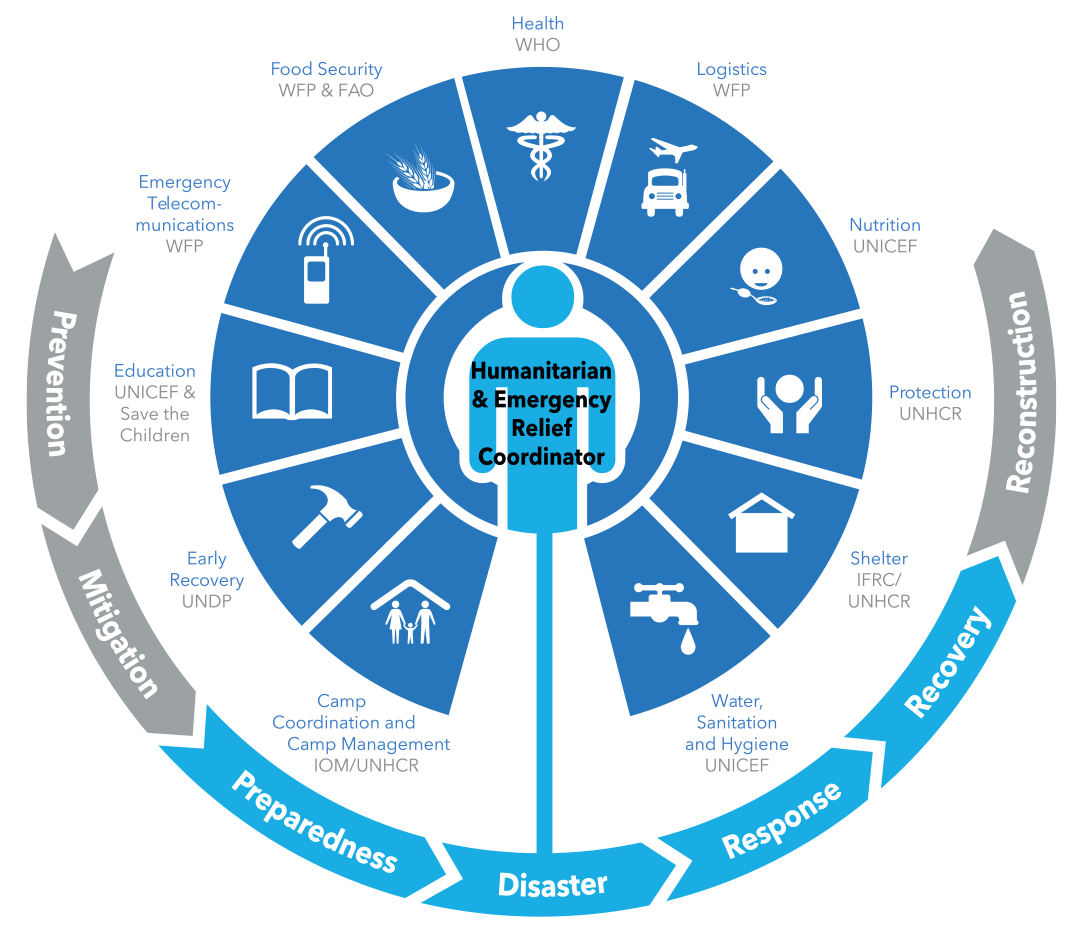1.1 Participate in humanitarian structures
To integrate child and adolescent health into humanitarian action effectively, governments and organizations must be able to navigate humanitarian structures.
1.1.1 UN agencies and cluster approach
To improve coordination and cooperation in humanitarian emergencies, the UN and humanitarian organizations have formalized some aspects of humanitarian action.
Global level
At the global level, the Inter-Agency Standing Committee (IASC) 1 coordinates humanitarian action and is headed by the Emergency Relief Coordinator. IASC is composed of UN agencies and international nongovernmental organizations. It is responsible for coordinating key agencies, assigning responsibilities and sharing resources and information. IASC designates responsibility for particular aspects of humanitarian action to particular agencies using a cluster approach (Fig. 6).

Fig. 6 Clusters and global lead agencies for humanitarian action (21)
National level
At the national level, clusters may be formally activated during major humanitarian emergencies if the existing government structures are not capable of responding adequately (see Annex 2). The in-country cluster lead may be different to the global lead agencies shown in Fig. 6. Ideally, the clusters should be led by, or at least in close cooperation with, national authorities. Clusters should complement existing response mechanisms. UNOCHA or the national government typically has responsibility for oversight of all the clusters.
Experience shows that humanitarian emergencies attract a wide range of actors. To be effective at a country level, clusters must do more than just provide a platform for information sharing – they must also maintain an ability to make coordinated decisions about resources, activities and strategic direction.
The health cluster lead is usually a government department or UN agency, often in a coalition. However, governance structures may not always be clear, particularly in the early stages of an emergency.
Section 1.3 recommends establishing a child and adolescent working group within the health cluster to provide a clear voice on the health needs of newborns, children and adolescents and appropriate responses. If a health cluster is not formally activated, the CAH working group can still fulfil these roles, and should preferably be led by the ministry of health.
Key actions – humanitarian structures
Adapted from the Sphere Health Standards (1)
- list-style-type: square; Identify what organization leads the health cluster at your level (e.g. national or subnational). Contact them to find out about coordination activities and communication channels. Communicate areas that you are working in or may be able to help coordinate.
- If existing mechanisms are weak or non-existent, support authorities to create a coordination mechanism for humanitarian action. Ideally, representatives of the ministry of health should lead health sector/cluster coordination. When the health ministry lacks the capacity or willingness to provide leadership in the response, an alternate agency with the necessary capacity must be identified (usually OCHA) to take the lead in health sector/cluster coordination.
- The health sector/cluster should hold regular health coordination meetings for local and external partners at central, subnational and field levels within the health sector, and between health and other sectors and appropriate cross-cutting theme groups. All health-related organizations should participate in these meetings and contribute to the coordination of activities.
- The health sector/cluster should regularly produce and disseminate updates and health sector bulletins. All health-related organizations should contribute to and help disseminate these messages.
Key indicators
- Your organization is connected with the health sector/cluster in your region, actively communicates with partners and contributes to health (and other) sector/cluster updates.
1 Inter-Agency Standing Committee (https://interagencystandingcommittee.org/).
Previous Next